Thermal Requirements of Ooencyrtus submetallicus (Hym.: Encyrtidae) and Telenomus podisi (Hym.: Platygastridae) Parasitizing Euschistus heros Eggs (Hem.: Pentatomidae)
Abstract
Simple Summary
Abstract
1. Introduction
2. Materials and Methods
2.1. Rearing and Maintenance of Insects Used in the Experiments
2.1.1. Ooencyrtus submetallicus
2.1.2. Telenomus podisi
2.1.3. Euschistus heros
2.2. Experimental Development and Analysis
2.2.1. Comparative Biology of O. submetallicus and T. podisi
2.2.2. Effect of Temperature on the Development of O. submetallicus and T. podisi
2.2.3. Estimates of the Thermal Requirements and Number of Generations of O. submetallicus and T. podisi
3. Results
3.1. Comparative Biology of O. submetallicus and T. podisi
3.2. Effect of Temperature on the Development of O. submetallicus and T. podisi
3.3. Thermal Requirements and Estimate of the Number of Generations of O. submetallicus and T. podisi
4. Discussion
5. Conclusions
Author Contributions
Funding
Institutional Review Board Statement
Informed Consent Statement
Data Availability Statement
Acknowledgments
Conflicts of Interest
References
- Wiest, A.; Barreto, M.R. Evolução dos Insetos-Praga na Cultura da Soja no Mato Grosso. EntomoBrasilis 2012, 5, 84–87. [Google Scholar] [CrossRef][Green Version]
- Corrêa-Ferreira, B.S.; Panizzi, A.R. Percevejos da Soja e Seu Manejo; Circular Técnica, 24; Embrapa—CNPSo: Londrina, Brazil, 1999; p. 45. [Google Scholar]
- Corrêa-Ferreira, B.S.; Sosa-Gómez, D.R. Percevejos e o Sistema de Produção Soja/Milho; Documentos, n. 397; Embrapa Soja: Londrina, Brazil, 2017; p. 98. [Google Scholar]
- Corrêa-Ferreira, B.S.; Castro, L.C.; Roggia, S.; Cesconetto, N.L.; Da Costa, J.M.; De Oliveira, M.C.N. MIP-Soja: Resultados de uma Tecnologia Eficiente e Sustentável no Manejo de Percevejos no Atual Sistema Produtivo da Soja; Documentos, n. 341; Embrapa Soja: Londrina, Brazil, 2013; p. 55. [Google Scholar]
- Bueno, A.F.; Sosa-Gómez, D.R.; Corrêa-Ferreira, B.S.; Moscardi, F.; Bueno, R.C.O.F. Inimigos naturais das pragas da soja. In Soja: Manejo Integrado de Insetos e Outros Artrópodes-Praga, 1st ed.; Hoffmann-Campo, C.B., Corrêa-Ferreira, B.S., Moscardi, F., Eds.; Editora: Embrapa. DF, Brazil, 2012; Volume 1, pp. 493–629. [Google Scholar]
- Wilson, F.; Woolcock, L.T. Temperature determination of sex in a parthenogenetic parasite, Ooencyrtus submetallicus (Howard) (Hymenoptera: Encyrtidae). Aust. J. Zool. 1960, 8, 153–169. [Google Scholar]
- Golin, V.; Loiácono, M.S.; Margaría, C.B.; Aquino, D.A. Natural incidence of egg parasitoids of Edessa meditabunda (F.) (Hemiptera: Pentatomidae) on Crotalaria spectabilis in Campo Novo do Parecis, MT, Brazil. Neotrop. Entomol. 2011, 40, 617–618. [Google Scholar] [PubMed]
- Sanomia, W.Y.; Pereira, F.F.; Silva, I.F. Inseticide selectivity to Ooencyrtus submetallicus (Hymenoptera: Encyrtidae) under extended laboratory conditions. Pesqui. Agropecu. Trop. 2020, 50, 1–8. [Google Scholar] [CrossRef]
- Stecca, C.S.; Bueno, A.F.; Pasini, A.; Silva, D.M.; Andrade, K.; Zirondi Filho, D.M. Impact of Inseticticides Used in Soybean Crops to the Egg Parasitoid Telenomus podisi (Hymenoptera: Platygastroidae). Neotrop. Entomol. 2018, 47, 281–291. [Google Scholar] [PubMed]
- Pereira, F.F.; Zanuncio, J.C.; Oliveira, H.N.; Grance, E.L.V.; Pastori, P.L.; Gava-Oliveira, M.D. Thermal requeriments and estimate number of generations of Palmistichus elaeisis (Hymenoptera: Eulophidae) in diferente Eucalyptus plantations regions. Braz. J. Biol. 2011, 71, 431–436. [Google Scholar] [CrossRef]
- Selvaraj, S.; Ganeshamoorthi, P.; Pandiaraj, T. Potential impacts of recente climate change on biological control agentes on agro-ecosystem: A review. Int. J. Biodivers. Conserv. 2013, 5, 845–852. [Google Scholar]
- Bueno, R.C.O.F.; Carneiro, T.R.; Pratissoli, D.; Bueno, A.F.; Fernandes, O.A. Biology and thermal requirements of Telenomus remus reared on fall armyworm Spodoptera frugiperda eggs. Cienc. Rural 2008, 38, 1–6. [Google Scholar] [CrossRef]
- Huang, Z.; Ren, S.; Musa, P.D. Effects of temperature on development, survival, longevity, and fecundity of the Bemisia tabaci Gennadius (Hemiptera:Aleyrodidae) predator, Axinoscymnus cardilobus (Coleoptera: Coccinellidae). Biol. Control 2008, 46, 209–215. [Google Scholar] [CrossRef]
- Mawela, K.V.; Kfir, R.; Krüger, K. Effect of temperature and host species on parasitismo, Development time and sex ratio oh the egg parasitoid Trichogrammatoidea lutea Girault (Hymenoptera: Trichogrammatidae). Biol. Control 2013, 64, 211–216. [Google Scholar] [CrossRef]
- Pomari, A.F.; Bueno, A.F.; Bueno, R.C.O.F.; Júnior-Menezes, A.O. Biological characteristics and thermal requerements of the biological control agente Telenomus remus (Hymenoptera: Platygastridae) reared on eggs of diferente species of the genus Spodoptera (Lepidoptera: Noctuidae). Ann. Entomol. Soc. Am. 2012, 105, 73–81. [Google Scholar] [CrossRef]
- Pratissoli, D.; Pezzopane, J.E.M.; Esposti, M.D.D.; Bertazo, C.L.; Fornazie, J.M. Estimativa do Número de Gerações de Trichogramma pretiosum Riley na Traça do Tomateiro Tuta absoluta (Meyrick), com Base nas Exigências Térmicas. An. Soc. Entomol. Bras. 1998, 27, 109–115. [Google Scholar] [CrossRef]
- Borges-Filho, R.C.; Nava, D.E.; Polanczyk, R.A.; Marangon, R.B.; Loiácono, M. Biology of Telenomus pachycoris (Hymenoptera: Scelionidae), a parasitoid of eggs of Pachycoris torridus (Hemiptera: Scutelleridae): The effects of egg age, exposure time, and temperature. Fla. Entomol. 2017, 100, 375–379. [Google Scholar] [CrossRef][Green Version]
- Cividanes, F.J.; Figueiredo, J.G.; Carvalho, D.R. Previsão da emergência de Trissolcus brochymenae (Ashmead) e Telenomus podisi (Ashmead) (Hymenoptera: Scelionidae) em condições de campo. Sci. Agric. 1998, 55, 1–5. [Google Scholar] [CrossRef]
- Taguti, E.A.; Gonçalves, J.; Bueno, A.F.; Marchioro, S.T. Telenomus podisi parasitism on Dichelops melacanthus and Podisus nigrispinus eggs at different temperatures. Fla. Entomol. 2019, 102, 607–613. [Google Scholar] [CrossRef]
- Braz, E.C.; Bueno, A.F.; Colombo, F.F.; Queiroz, A.P. Temperature impact on Telenomus podisi emergence in field releases of Unprotected and Encapsulated parasitoid pupae. Neotrop. Entomol. 2021, 50, 462–469. [Google Scholar] [CrossRef]
- Torres, J.B.; Pratissoli, D.; Zanuncio, J.C. Thermal Requirements and Development of the Egg Parasitoids Telenomus podisi Ashmead and Trissolcus brochymenae (Ashmead) on the Predator Stinkbug Podisus nigrispinus (Dallas). An. Soc. Entomol. Bras. 1997, 26, 445–453. [Google Scholar] [CrossRef]
- Faca, E.C.; Pereira, F.F.; Fernandes, W.C.; Silva, I.F.; Costa, V.A.; Wengrat, A.P.G.S. Reproduction of Ooencyrtus submetallicus (Hymeniptera: Encyrtidae) and trissolcus sp. aff. urichi (Hymenoptera:Scelionidae) in eggs of Nezara viridula (hemiptera: Pentatomidae) of differen ages. J. Agric. Sci. 2021, 13, 96–106. [Google Scholar]
- Panizzi, A.R.; Mcpherson, J.E.; James, D.G.; Javahery, M.; Mcpherson, R.M. Stink bugs (Pentatomidae). In Heteroptera of Economic Importance, 1st ed.; Schaefer, C.W., Panizzi, A.R., Eds.; CRC Press: New York, NY, USA, 2000; Volume 1, pp. 421–474. [Google Scholar]
- Haddad, M.L.; Moraes, R.C.B.; Parra, J.R.P. Mobae, Modelos Bioestatísticos Aplicados à Entomologia, 1st ed.; ESALQ/USP: Piracicaba, Brazi, 1995; Volume 44. [Google Scholar]
- Oliveira, F.A.L.D.; Silva, R.O.; Oliveira, N.R.X.D.; Andrade, G.S.; Pereira, F.F.; Zanuncio, J.C.; Coutinho, C.R.; Pastori, P.L. Reproduction of Trichospilus diatraeae (Hymenoptera: Eulophidae) with Different Densities and Parasitism Periods in Anticarsia gemmatalis (Lepidoptera: Noctuidae) Pupae. Folia Biol. 2018, 66, 103–110. [Google Scholar] [CrossRef]
- Bueno, R.C.O.F.; Parra, J.R.P.; Bueno, A.F.; Haddad, M. Desempenho de Tricogramatídeos como Potenciais Agentes de Controle de Pseudoplusia includens Walker (Lepidoptera: Noctuidae). Neotrop. Entomol. 2009, 38, 389–394. [Google Scholar] [CrossRef]
- Panizzi, A.R. History and contemporary perspectives of the integrated pest 342 management of soybean in Brazil. Neotrop. Entomol. 2013, 42, 119–127. [Google Scholar] [CrossRef]
- Tunca, H.; Colombel, E.; Venard, M.; Tabone, E. Incidence of superparasitism in the egg parasitoid, Ooencyrtus kuvane Howard (Hymenoptera: Encyrtidae). Biocontrol Sci. Technol. 2017, 27, 796–808. [Google Scholar] [CrossRef]
- Pacheco, D.J.P.; Corrêa-Ferreira, B.S. Potencial reprodutivo e longevidade do parasitoide Telenomus podisi Ashmead, em ovos de diferentes espécies de percevejos. An. Soc. Entomol. Bras. 1998, 27, 585–591. [Google Scholar] [CrossRef][Green Version]
- Favero, K.; Pereira, F.F.; Torres, J.B.; Oliveira, H.N.; Kassab, S.O.; Zanuncio, J.C. Reproduction of Tetrastichus howardi (Hymenoptera: Eulophidae) in Diatraea saccharalis (Lepidoptera: Crambidae) Pupae at Different Temperatures. Fla Entomol. 2015, 98, 865–869. [Google Scholar] [CrossRef][Green Version]
- Parra, J.R.P. Técnicas de criação de Anagasta kuehniella, hospedeiro alternativo para produção de Trichogramma. In Trichogramma e o Controle Biológico Aplicado, 1st ed.; Parra, J.R.P., Zucchi, R.A., Eds.; Fealq: Piracicaba, Brazi, 1997; Volume 1, pp. 121–150. [Google Scholar]
- Pratissoli, D.; Parra, J.R.P. Desenvolvimento e exigências térmicas de Trichogramma pretiosum Riley, criados em duas traças do tomateiro. Pesq. Agropecu. Bras. 2000, 35, 1281–1288. [Google Scholar] [CrossRef][Green Version]
- Krugner, R.; Daane, K.M.; Lawson, A.B.; Yokota, G.Y. Temperature-dependent development of Macrocentrus iridescens (Hymenoptera: Braconidae) as a parasitoid of the obliquebanded leafroller (Lepidoptera: Tortricidae): Implications for field synchrony of parasitoid and host. Biol. Control 2007, 42, 110–118. [Google Scholar] [CrossRef]
- Pastori, P.L.; Zanuncio, J.C.; Pereira, F.F.; Pratissoli, D.; Cecon, P.R.; Serrão, J.E. Desenvolvimento e exigências térmicas de Trichospilus diatraeae Cherian & Margabandhu (Hymenoptera: Eulophidae) criado em pupas de Anticarsia gemmatalis (Hübner) (Lepidoptera: Noctuidae). Rev. Bras. Biocienc. 2011, 10, 79–85. [Google Scholar]
- Nakama, P.A.; Foerster, L.A. Effects of alternating temperatures on the development and emergence of Trissolcus basalis (Wollaston) e Telenomus podisi Ashmead (Hymenoptera: Scelionidae). Neotrop. Entmol. 2001, 30, 269–275. [Google Scholar] [CrossRef]
- Power, N.A.; Ganjisaffar, F.; Perring, T.M. Effect of temperature on the survival and developmental rate of immature Ooencyrtus mirus (Hymenoptera: Encyrtidae). J. Econ. Entomol. 2020, 113, 1675–1684. [Google Scholar] [CrossRef]
- Yeargan, K. Effects of temperature on Developmental Rate of Telenomus podisi (Hymenoptera: Scelionidae). Ann. Entomol. Soc. Am. 1980, 73, 339–342. [Google Scholar] [CrossRef]
- Queiroz, A.P.; Favetti, B.M.; Hayashida, R.; Grande, M.L.M.; Neiva, M.M.; Panizzi, A.R.; Bueno, A.F. Effect of the ages parasitoid and host eggs on Telenomus podisi (Hymenoptera: Platygastridae) parasitism. Neotrop. Entomol. 2019, 48, 974–982. [Google Scholar] [CrossRef] [PubMed]
- Milosavljevic, I.; Mccalla, K.A.; Ratkowsky, D.A.; Hoddle, M.S. Effects of constant and fluctuating temperatures on development rates and longevity of Diaphorencyrtus aligarhensis (Hymenoptera: Encyrtidae). J. Econ. Entomol. 2019, 112, 1062–1072. [Google Scholar] [CrossRef] [PubMed]
- Mccalla, K.A.; Keçeci, M.; Milosavljevic, I.; Ratkowsky, D.A.; Hoddle, M.S. History parameters and thermal performance curves of Tamarixia radiata (Hymenoptera: Eulophidae), a parasitoid oh the Asian Citrus Psyllid (Hemiptera: Liviidae). J. Econ. Entomol. 2019, 112, 1560–1574. [Google Scholar] [CrossRef]
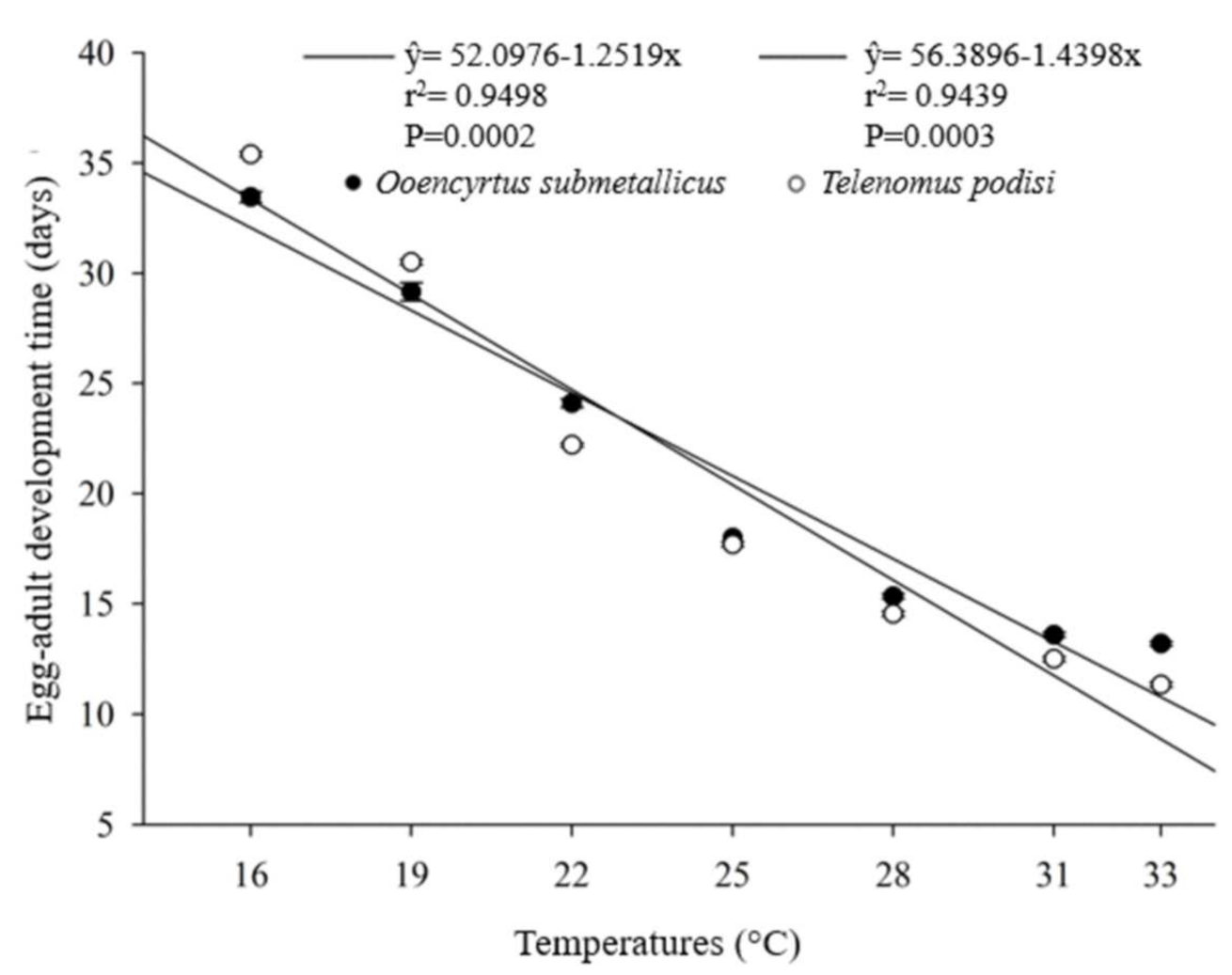
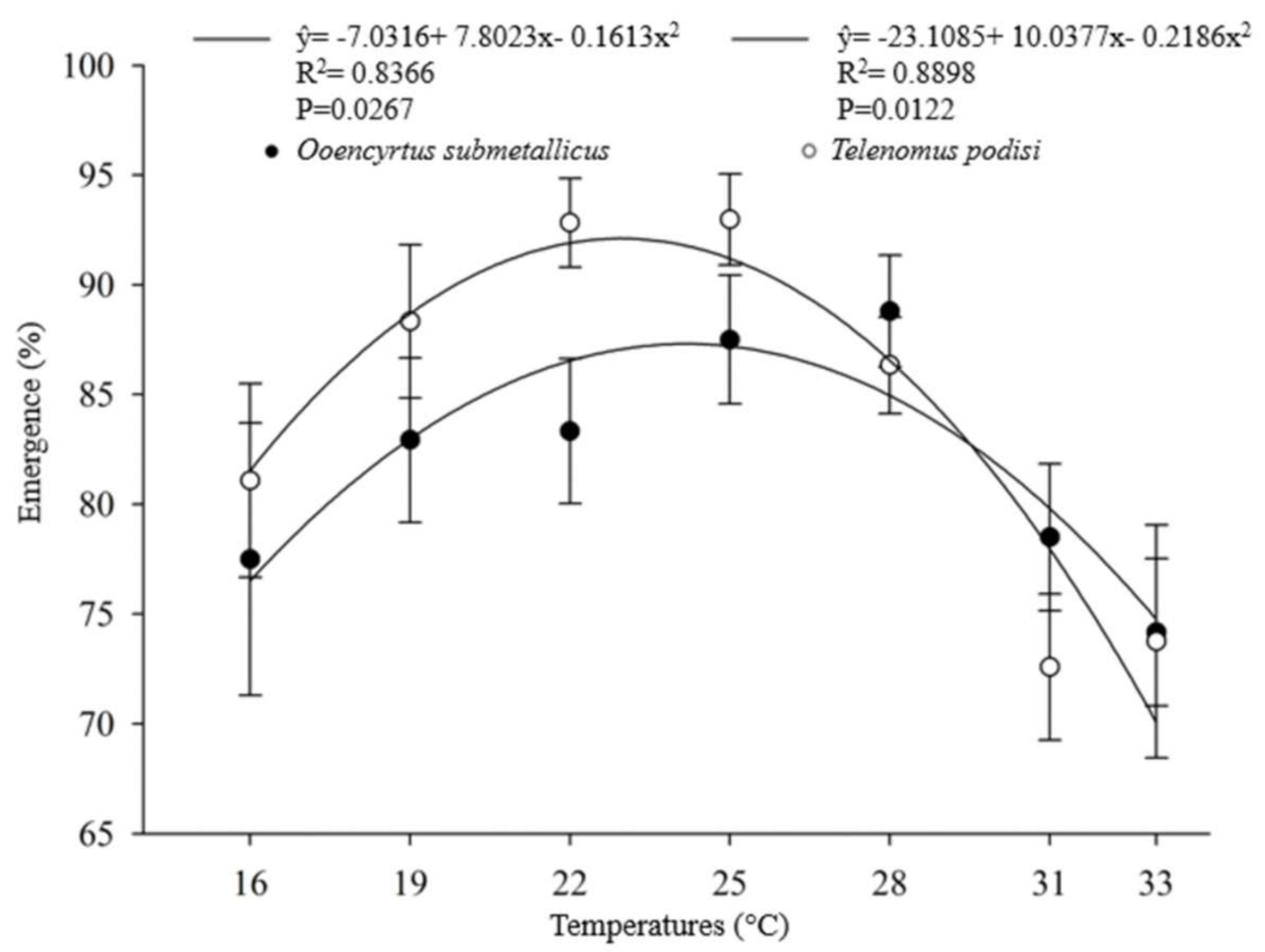
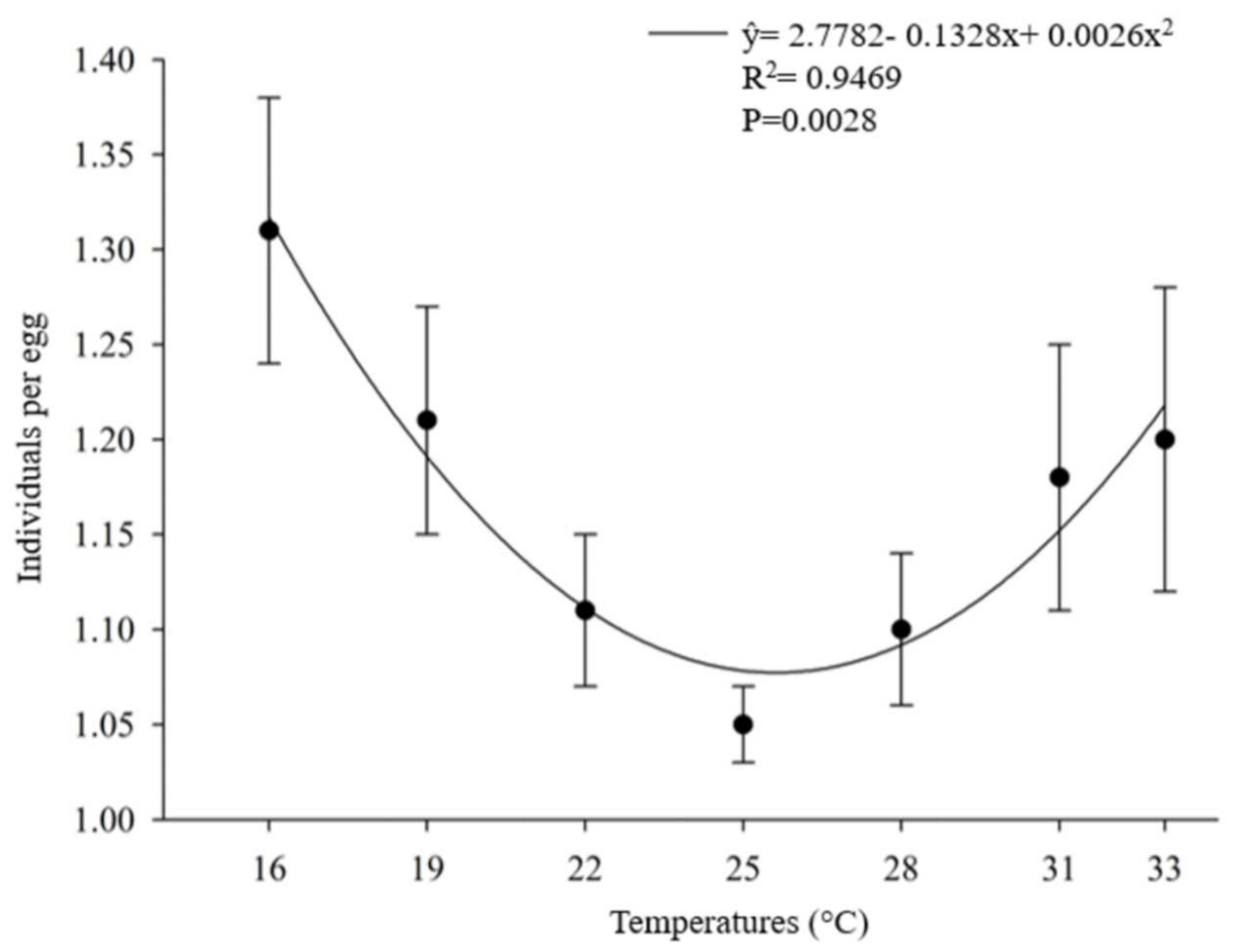
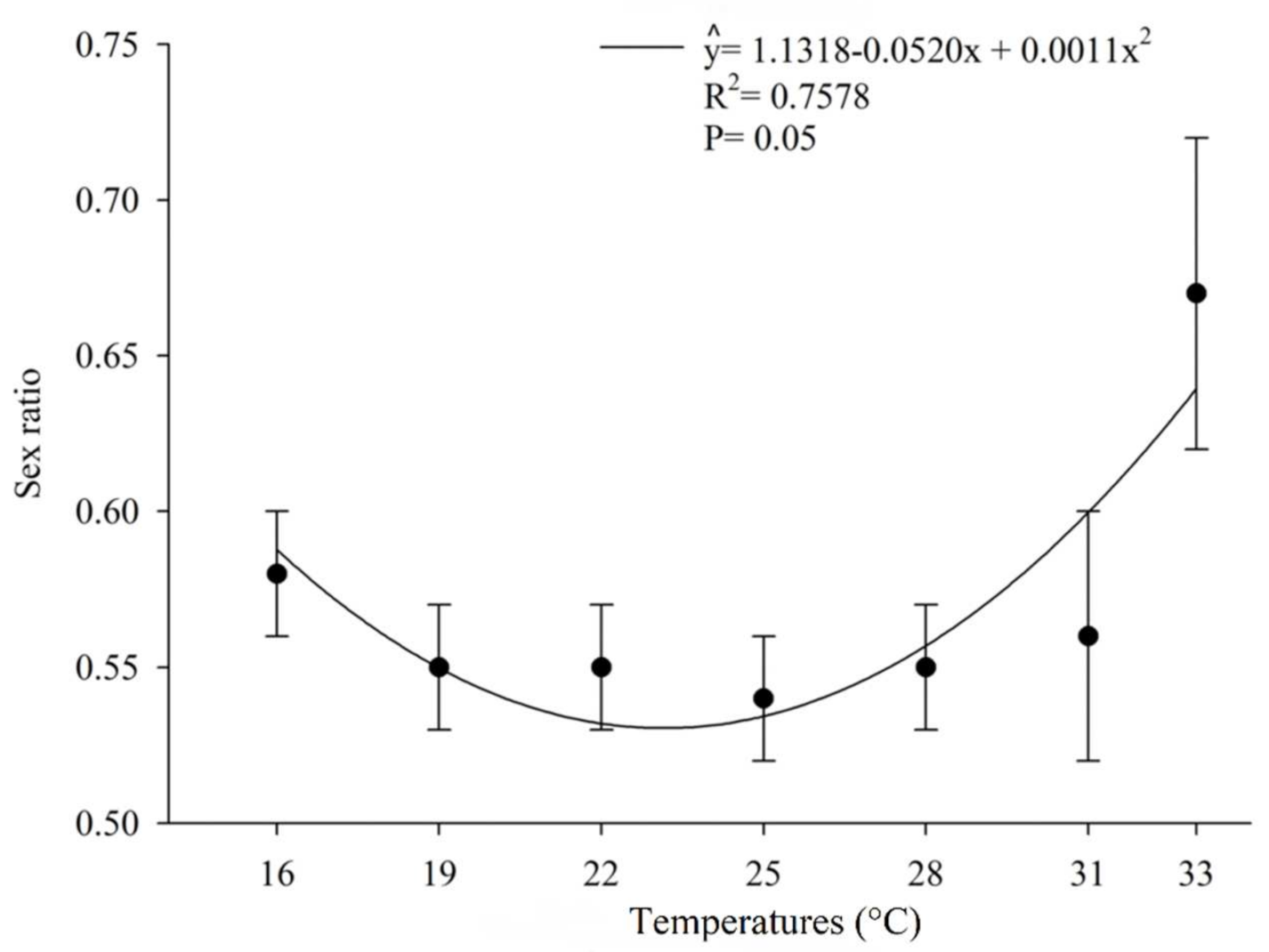
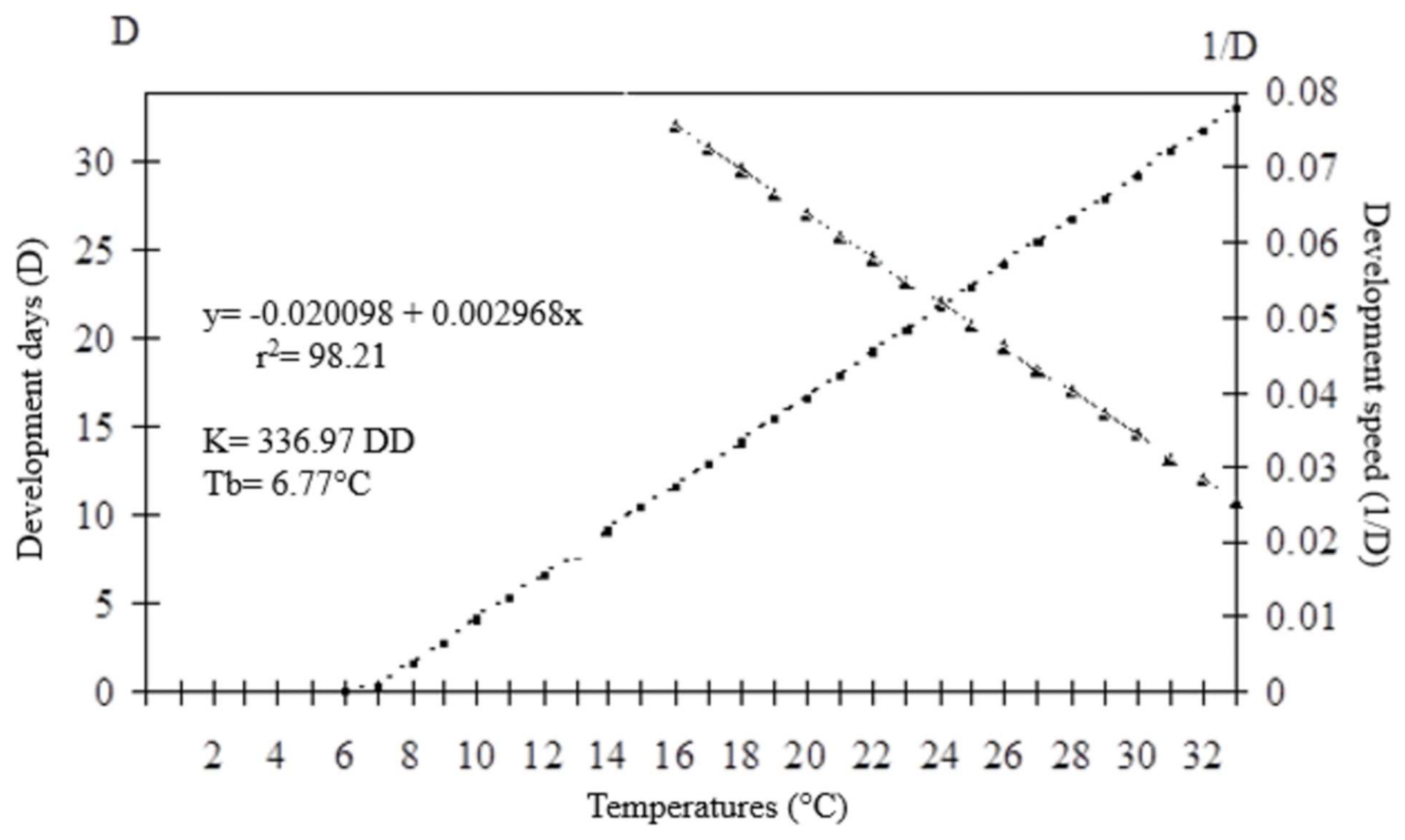
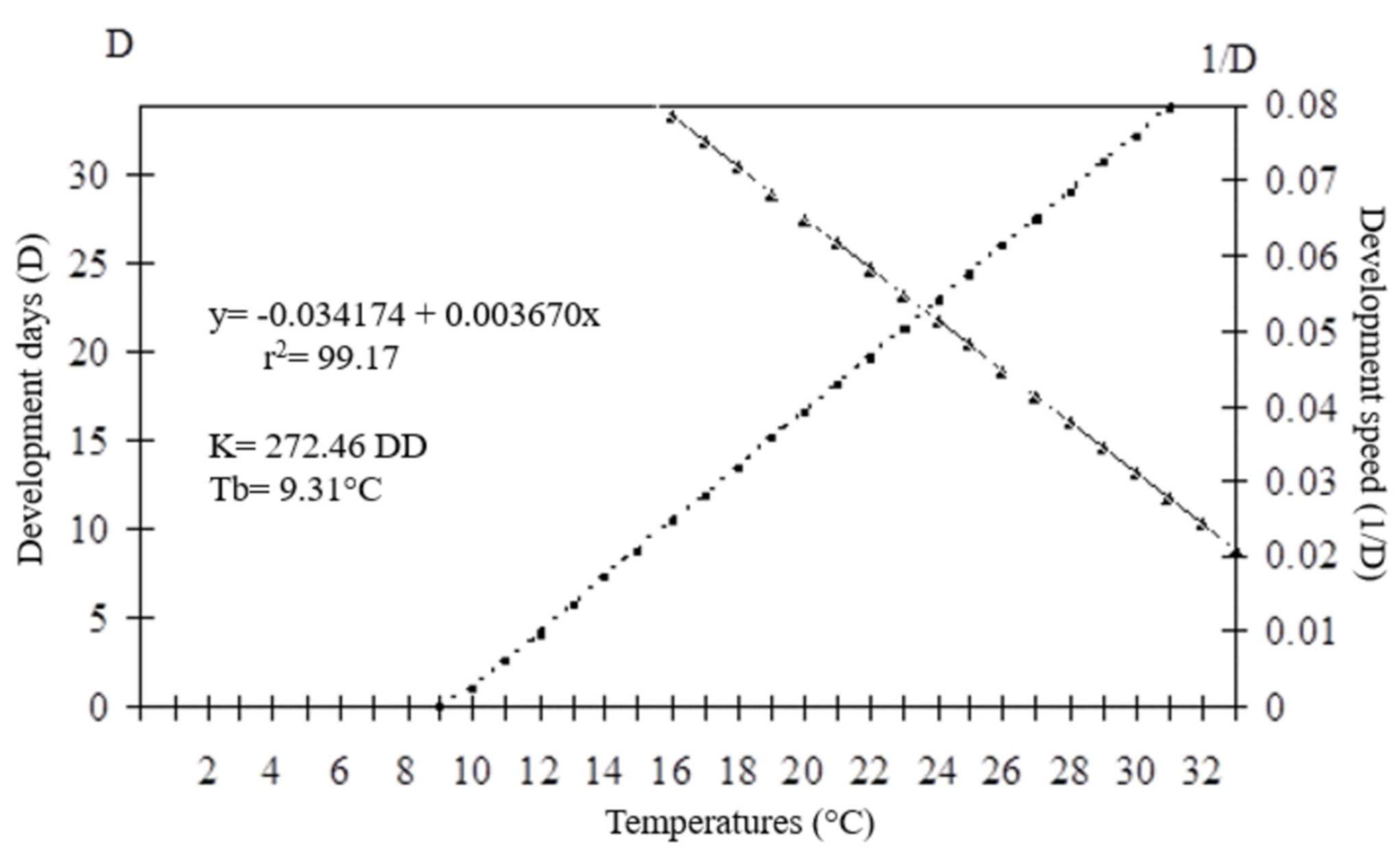
| Characteristics | O. submetallicus | T. podisi | CV (%) |
|---|---|---|---|
| Cycle length (egg–adult) (days) | 17.7 ± 0.10 a | 17. 5 ± 0.11 a | 2.72 |
| Parasitism (%) | 59.0 ± 1.43 a | 62.5 ± 1.22 a | 9.83 |
| Emergence (%) | 86.4 ± 2.26 a | 87.3 ± 2.08 a | 11.43 |
| Sex ratio | 1.0 ± 0.00 a | 0.5 ± 0.02 b | 6.76 |
| Individuals emerged per egg (n) | 1.9 ± 0.05 a | 1.2± 0.04 b | 12.11 |
| Longevity without food (days) | 9.6 ± 0.47 a | 10.8 ± 0.51 a | 21.57 |
| Longevity with food (days) | 18.1 ± 0.82 a | 19.9 ± 0.83 a | 19.60 |
| Localities | T. podisi | O. submetallicus | E. heros |
|---|---|---|---|
| Tupanciretã, RS | 11.43 | 11.99 | 4.05 |
| Mal. Cândido Rondon, PR | 13.12 | 13.36 | 5.46 |
| Maracaju, MS | 15.47 | 15.26 | 7.41 |
| Dourados, MS | 18.29 | 18.33 | 9.76 |
| Ponta Porã, MS | 15.29 | 16.39 | 8.57 |
| Sorriso, MT | 18.82 | 18.78 | 11.03 |
| Rio Verde, GO | 15.05 | 14.92 | 7.06 |
Publisher’s Note: MDPI stays neutral with regard to jurisdictional claims in published maps and institutional affiliations. |
© 2021 by the authors. Licensee MDPI, Basel, Switzerland. This article is an open access article distributed under the terms and conditions of the Creative Commons Attribution (CC BY) license (https://creativecommons.org/licenses/by/4.0/).
Share and Cite
Chaves, V.F.; Pereira, F.F.; Torres, J.B.; da Silva, I.F.; Pastori, P.L.; de Oliveira, H.N.; Costa, V.A.; Cardoso, C.R.G. Thermal Requirements of Ooencyrtus submetallicus (Hym.: Encyrtidae) and Telenomus podisi (Hym.: Platygastridae) Parasitizing Euschistus heros Eggs (Hem.: Pentatomidae). Insects 2021, 12, 924. https://doi.org/10.3390/insects12100924
Chaves VF, Pereira FF, Torres JB, da Silva IF, Pastori PL, de Oliveira HN, Costa VA, Cardoso CRG. Thermal Requirements of Ooencyrtus submetallicus (Hym.: Encyrtidae) and Telenomus podisi (Hym.: Platygastridae) Parasitizing Euschistus heros Eggs (Hem.: Pentatomidae). Insects. 2021; 12(10):924. https://doi.org/10.3390/insects12100924
Chicago/Turabian StyleChaves, Valeria Freitas, Fabricio Fagundes Pereira, Jorge Braz Torres, Ivana Fernandes da Silva, Patrik Luiz Pastori, Harley Nonato de Oliveira, Valmir Antônio Costa, and Carlos Reinier Garcia Cardoso. 2021. "Thermal Requirements of Ooencyrtus submetallicus (Hym.: Encyrtidae) and Telenomus podisi (Hym.: Platygastridae) Parasitizing Euschistus heros Eggs (Hem.: Pentatomidae)" Insects 12, no. 10: 924. https://doi.org/10.3390/insects12100924
APA StyleChaves, V. F., Pereira, F. F., Torres, J. B., da Silva, I. F., Pastori, P. L., de Oliveira, H. N., Costa, V. A., & Cardoso, C. R. G. (2021). Thermal Requirements of Ooencyrtus submetallicus (Hym.: Encyrtidae) and Telenomus podisi (Hym.: Platygastridae) Parasitizing Euschistus heros Eggs (Hem.: Pentatomidae). Insects, 12(10), 924. https://doi.org/10.3390/insects12100924







